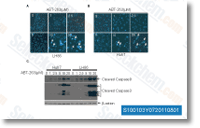4% from the higher expression group. How ever, once the patients with N1 two 3 classifications had been analyzed, the survival price was 71. 4% while in the reduced expression group and fifty five. 6% inside the large expression group. In our review, 26. 7% of sufferers had died during the M0 group at the time of evaluation, plus the sufferers with very low Bmi 1 expression showed longer survival times. The survival fee was 84. 8% during the minimal Bmi one expression group in contrast to 67. 4% during the high Bmi one expression group. A equivalent outcome was located in individuals with stage II IIIIV, in accordance towards the Bmi 1 expression. The survival price was 80. 8% from the reduced Bmi 1 expression subset in contrast to 58. 8% inside the higher Bmi 1 expression subset. Taken collectively, these final results indicate that Bmi one can be beneficial to evaluate the prognosis in sufferers with breast cancer. Analyses of relative dangers indicative of Bmi 1s function while in the prognosis of breast cancer In our analyses, we defined a relative possibility of 1.
000 because the baseline in patients with the following qualities, age, T1, N0, M0, clinical stage I, very low Bmi 1 expression plus the absence of ER, PR and HER 2. To find out if Bmi 1 could serve like a chance element with clin ical usefulness, Cox regression proportional hazard ana lyses had been employed to examine the relative chance. As witnessed in Table 4, univariate Cox regression analyses unveiled that a substantial level of Bmi AMN-107 ic50 1 was associated by using a substantially greater risk of death in breast cancer patients. The relative chance elevated by pretty much 4 fold in sufferers with substantial Bmi 1 expression compared to those with very low Bmi one expression. As anticipated, significant tumor dimension, lymph node involvement, distant metastasis and superior clini cal stage had been also sig nificant unfavorable prognostic variables.
However, the presence of PR was a favorable prognostic issue, though the presence of ER and HER two didn’t predict the favorable or unfavorable survival. The clinical stage, a detailed index reflecting T, BML-190 N, and M classifications, could be the most commonly applied prognostic aspect during the clinic. Just after adjustment for con founding variables, Bmi 1 was uncovered to predict bad survi val by multivariate Cox regression analyses when clinical stage, PR presence and Bmi one expression were incorporated. Also, superior clinical stage nonetheless pre dicted unfavorable prognosis. PR was also recognized as being a prospective prognostic issue by multi variate Cox regression evaluation. Consequently, our findings indicate that Bmi 1 protein expres sion features a significant correlation together with the prognosis of breast cancer. Exogenous expression of Bmi one enhances cell motility and invasion of immortalized HMECs Cell motility and invasion are indispensable for  cancer metastasis. Mainly because Bmi 1 expression was correlated with more substantial tumor size, lymph node involvement, distant metastasis and state-of-the-art clinical stage in breast cancer tissues, we hypothesized that Bmi 1 could regulate the progression of breast cancer.
cancer metastasis. Mainly because Bmi 1 expression was correlated with more substantial tumor size, lymph node involvement, distant metastasis and state-of-the-art clinical stage in breast cancer tissues, we hypothesized that Bmi 1 could regulate the progression of breast cancer.
GFAP Signal
GFAP is encoded by the GFAP gene
